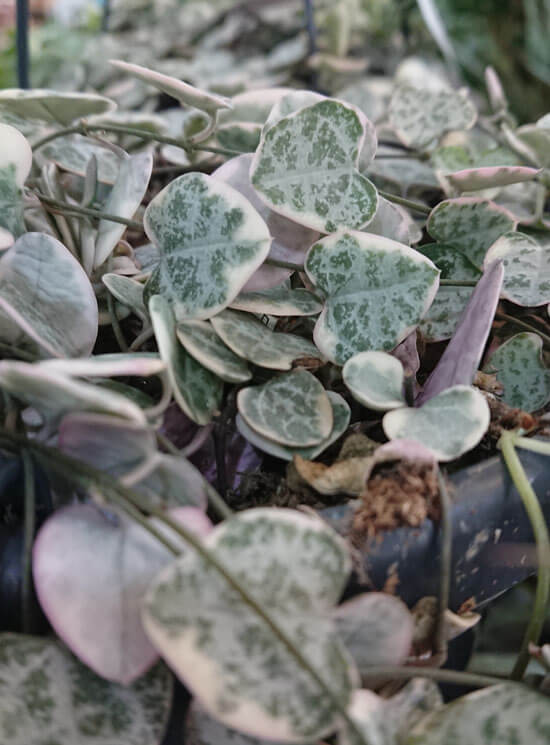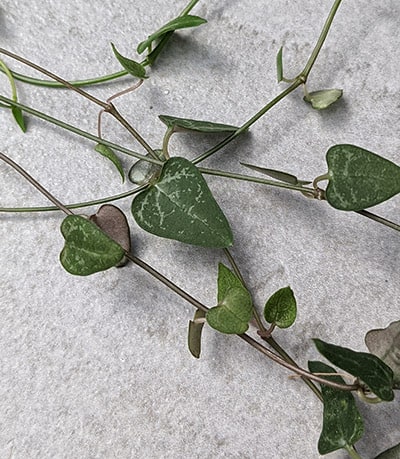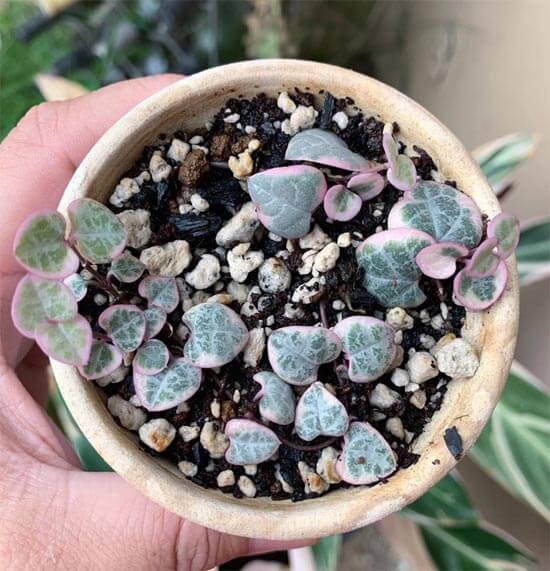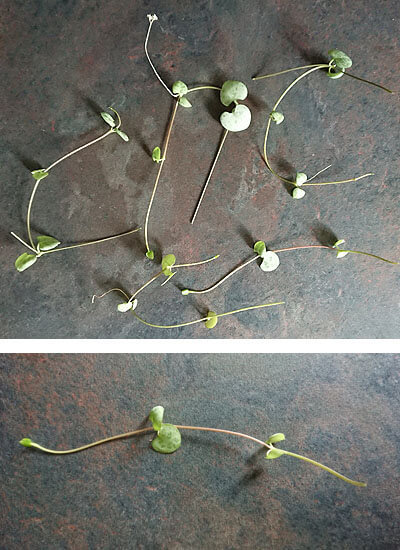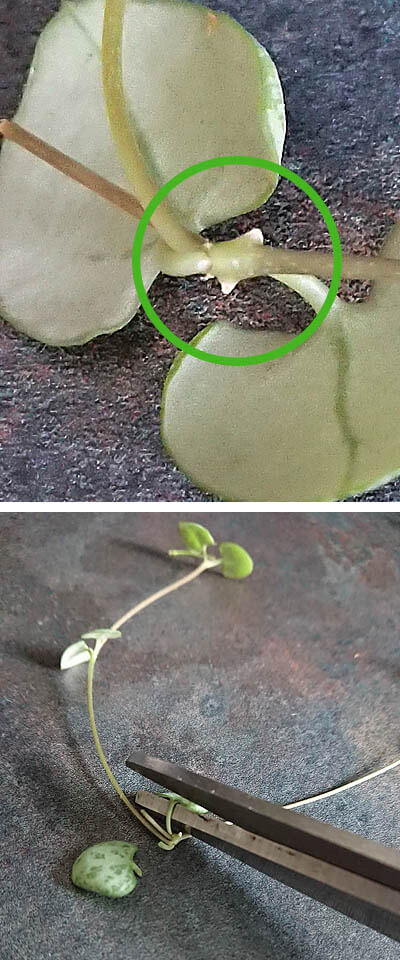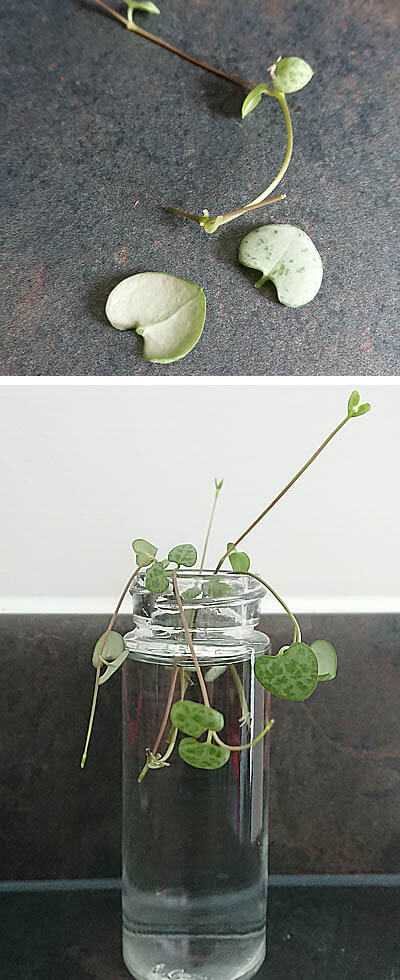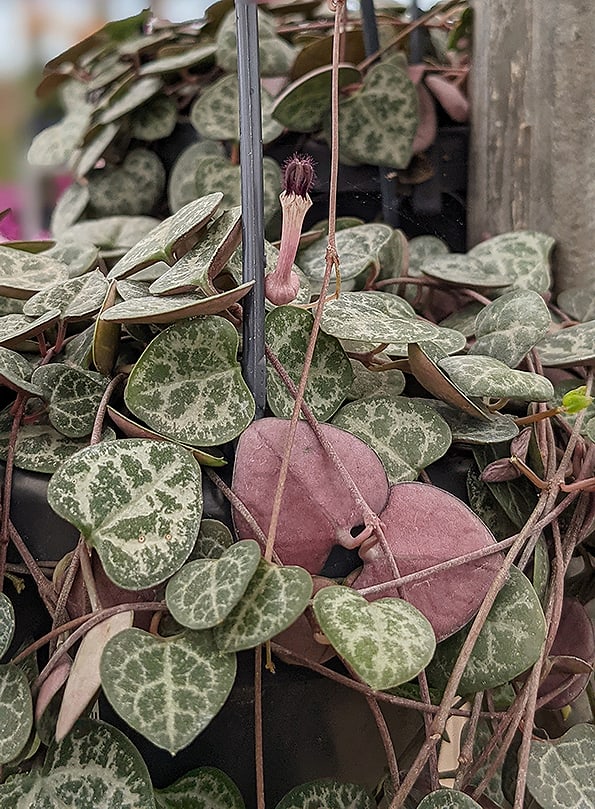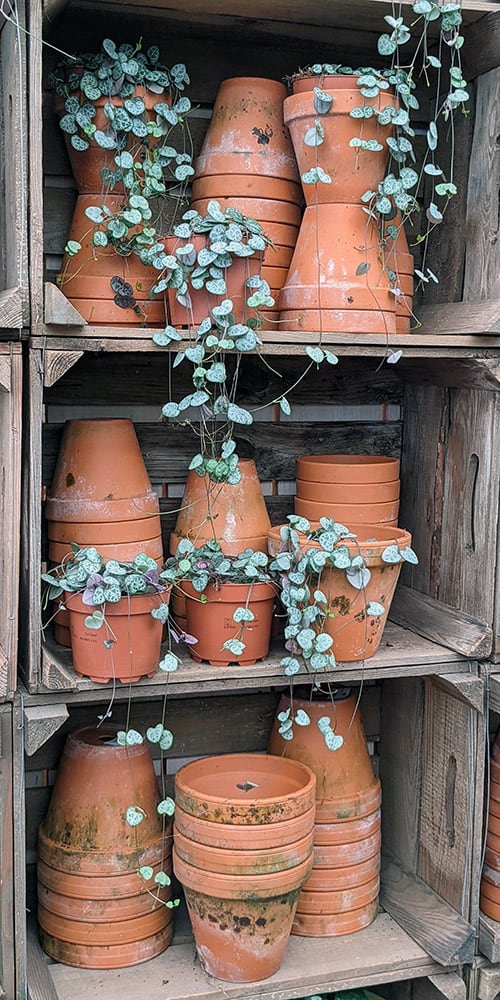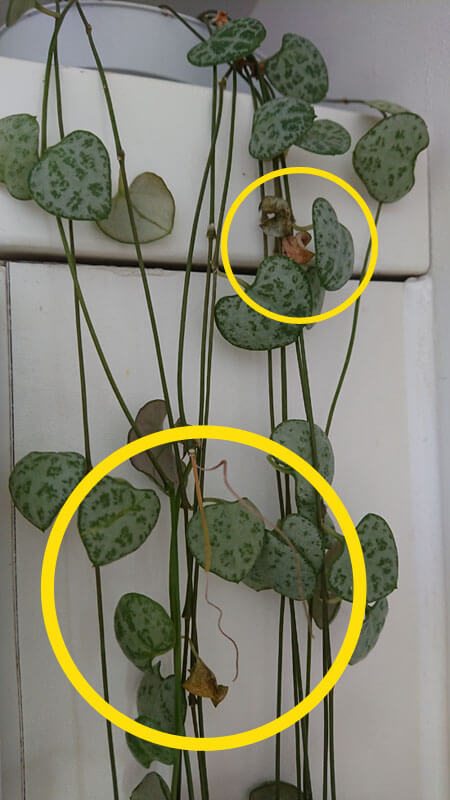The String of Hearts plant is a very easy care houseplant. Despite its small and sometimes delicate and fragile appearance, it's surprisingly robust and is a trendy and popular indoor plant.
It may also be called Chain of Hearts, Rosary Vine, Sweetheart Vine or even by the botanical name - Ceropegia Woodii. All common names come from the plant's subtle marbled heart-shaped leaves cascading from thin wiry stems.
String of Hearts plants are perfect for somewhere with a little full sun, bright indirect light or even medium light levels.
They can be grown in almost all homes and make exceptional hanging plants. Their small footprint ensures they perfectly suit narrow spaces where larger hanging plants would overwhelm the area.
Their semi-succulent nature ensures minimal ongoing upkeep – excellent news if your plant is nestled in a tricky-to-reach spot (like mine perched high atop a kitchen cupboard, or another on a tall bookcase!).
How do you pronounce Ceropegia Woodii correctly? Say:
Seer-oh-PEGGY-uh WOODY-eye
They grow fast, are fairly resistant to pests and diseases and will live happily in the same pot for several years. A further advantage is their non-toxicity, making them safe for homes with pets.
They used to be a little on the pricey side, but prices are very fair these days. Once you have one, they're super easy to propagate so you can create more easily.
If you have a friend or family member with one, try to pinch some propagating material so you can start your own for free.
The Variegated String of Hearts has the same care requirements but could be harder to find.
The varieties and cultivars of Ceropegia Woodii as a houseplant is limited to around four. You're most likely to come across either the standard variety or the variegated type.
To make things more complicated these two look remarkably similar at first glance because the standard is also slightly variegated, so can be hard to tell apart.
TIP - There are only a handful of cultivars currently available. The "standard" and "variegated" are the most common.
Ceropegia woodii 'variegata' (pictured above) is the variegated type. It features the same mottled green and silvery-grey on the leaf surface, but just before the leaf edges, these colors yield to a subtle purple hue. This coloration extends to the leaf's reverse, where the purple deepens.
Ceropegia woodii 'Silver Glory' (see first photo at the start of this article). Has a similar look shape wise but the leaves are broader and have a more apple than heart shape. They also have fairly limited blotches and variegation so can appear quite plain.
Ceropegia woodii 'Mini Star' have narrow leaves and they're a much lighter green. It may also be called "Heartless". It's the rarer of the four available so you may need to search this one out from online sellers.
Ceropegia woodii 'Mini Star' - Similar to the String of Spades or English Ivy, but with smaller leaves, this one makes a nice alternative.
Care requirements are the same and all can be propagated by stem cuttings quite easily and all look superb in a hanging basket. Pick whatever you like the most and you'll have a fab display in no time.
Different light conditions can also change the overall leaf color and placement of the marbled markings. I talk about that in the "problems" section of the article later.

Hi, I'm Tom!
If you're like me and enjoy the challenge of growing houseplants and getting them to thrive, then Ourhouseplants can help. This website shares my knowledge and years of growing plants and provides (hopefully) helpful advice on properly caring for your indoor plant friends.
This is an adaptable houseplant when it comes to light levels. It will put up with some lower light conditions and also some fairly bright spots. However avoid gloomy, low light conditions and intense sun-drenched south-facing windows.
You'll get the best looking leaves and good amounts of growth from having it in a bright location with just the occasional ray of sunlight hitting the growing stems.
As a semi-succulent, it can tolerate sporadic watering and dry soil conditions for a week or longer. In my experience, the plant thrives when watered thoroughly and then allowed to dry out almost completely before the next watering.
This could mean watering it once a week or so in Summer, and once every two weeks (or even less) in the Winter months.
TIP - Plump leaves will often mean the plant has enough water. On the flip side, if the leaves are feeling squishy or spongy, then it's a good sign that the soil is dry and it needs some more water.
Ultimately the amount of water it will need will depend on where you grow the plant in terms of how much heat and light it receives.
Plants in warm temperatures and high light locations will need more water than those growing in cooler and lower light spots.
The String of Hearts is highly susceptible to rot if the soil is kept constantly saturated or overwatered. So ensure you let the soil dry between waterings. Be extra careful if you're growing it in a cooler / lower light part of your home.
Young Variegated String of Hearts that's just been watered and won't need anymore for another week at least. Photo by Nicole over at bloom and fiddle
The stems, from the base to the tips, are thin and wiry and can be easily damaged by pests or disease. So when you have clusters of stems in the same pot, to discourage pests and disease, good ventilation is recommended.
However, the actual level of humidity itself is not overly important and your plant will put up with any levels found in most homes.
A specially formulated Cactus or Succulent feed is the ideal choice, but it won't turn its nose up at a regular all-purpose houseplant formulation if that's all you have.
Although the stems can grow to immense lengths, the plant doesn't need a great deal of fertiliser. Feeding four times a year is enough. I feed mine in Spring and Summer with a regular liquid fertilizer for houseplants.
15°C (59°F) - 25°C (77°F). This plant loves to be warm. So they should easily cope with both average and the hottest rooms in your home. On the flip side they don't like the cold.
They will be able to survive a mild frost and even some sub-zero temperatures providing the soil they're growing in is almost completely dry. However, some of the leaves and stems will be damaged.
Sub-zero temperatures are not a regular feature of modern homes, but just in case you're growing it outside in a garden or balcony to be absolutely safe I would suggest not letting the plants remain in temperatures that start to creep below 5°C (41°F).
In time the String of Hearts will produce fairly large tubers to store nutrients and water.
The root system of these plants stay quite basic which is why it's easy to grow so many stems close together in the same pot. This means they don't need much growing space.
Good drainage is essential as this will help aerate the soil and give the roots space to grow and prevent them from suffocating in tight, closed soils
All of this means outgrowing a pot does not occur very often and repotting is only needed infrequently. Anything between 2 and 4 years will be fine if you're feeding occasionally.
As mentioned the roots are fragile so some damage is almost certain when you start digging and moving the plant around, so do be gentle and careful.
This houseplant is also a prime candidate for some specialist soil. On many of my plant profile articles I say that standard potting compost is fine. However, in this instance, I suggest you avoid this and go for something much more open and naturally aerated.
This means growing it in a more free draining soil, like a Cactus or Succulent soil designed mix.
If you're not sure what I mean, below are links to Amazon products which should help. You can buy them from Amazon, or most local Garden Centre's and Nurseries should have something like this too.
If you'd rather not buy a specialist compost, make sure whatever you use is as open as possible and add grit or something to aid in drainage (more ideas mentioned in my growing mediums guide).
Good drainage is essential as this will help aerate the soil and give the roots space to grow and prevent them from suffocating in tight, closed soils.
In terms of the new pot, because these plants don't have extensive root systems they don't need a particularly deep or big container, so you could just slightly increase the size from the existing pot and it will be fine.
If you want to create more plants or bulk out your existing plant it's very easy to do by DIY propagation.
The String of Hearts looks best when several stems are growing close together in a pot. So when creating the cuttings you will need quite a few so be sure you have enough "material" on the existing plant before you start.
Cutting material to be used for String of Hearts propagation
New roots will grow from the nodes on the stem. But first we need to remove the leaves otherwise they will just rot in water / soil.
New roots will form in a matter of weeks, at which point you can transplant them into soil and then you'll have a new plant.
In a week or so, small white roots should be visible and a month later they will be ready to plant into some soil. Just be extra careful as everything will be quite delicate, it might even help to "dig" small holes with a pencil before slotting the cutting into place and gently covering the roots.
TIP - Make sure you use an open airy soil mix. Small cuttings will struggle and have stunted growth if the soil is heavy and compacted
Initially keep the soil "moist" for the first month or two. Afterward treat like a mature plant, by letting the soil almost fully dry out before watering again.
Other Approaches
It's super easy to propagate by cuttings and there is almost always a supply of cutting material as the mother plant will keep growing even after "pruning".
If you'd rather try something else you can also "layer" cuttings. You do this by laying a stem across a fresh pot of soil and then "pegging" the stem at the leaf nodes under the soil a little. New growth should be fairly rapid.
Fulfill the care instructions detailed above and you'll get rapid growth in Spring, Summer and Fall. During Winter you might get a little bit, but nowhere as much as other times of the year.
This is certainly a fast growing houseplant. Although plants grown in lower light, the wrong type of soil or without enough water will be put out new growth at a much slower rate.
The natural height straight upwards out of the pot will be no more than two or three inches (5cm to 7.5cm). Some people wrap their plants around and around to create a bird's nest-like appearance, which will then give a taller looking plant (see the first photo at the start of the article for the beginnings of a wrap).
The long trailing stems will just grow and grow
The spread can be huge and this comes from the long trailing stems, that will just grow and grow. They tend not to split or divide, so each stem just keeps inching along week by week (see photo at the end of the article to see a cascading plant).
They can get very long, so feel free to prune them at the bottom once they've reached a height / spread you're happy with. Don't forget you can use the clippings to create more plants.
Given the right conditions these plants do often flower indoors.
They look like tiny vases and although you might only get one or two of these flowers at a time, they're still a welcome sight as it will show your plant is happy and thriving in your care. They can appear at any time during the year, although they're rare in Winter.
They won't last long, and you can pull or cut off the dead flower once it's finished its show. Sometimes you can get little small white ball like pods appearing at the base of the flower.
As the stems are so tiny, it's probably best just to leave these pods where they are, otherwise trying to remove them could mean you damage the stem itself.
The flowers are quite small and straightforward, but still a welcome surprise
The plant itself is not toxic, so is safe around cats, dogs and people from that standpoint.
But anyone who has spent time with any Ceropegia Woodii will know that the leaves and stems hook and grab onto things easily. You don't want any pet or child playing with this plant simply because it can be pulled from it's home and destroyed in a matter of seconds.
Come see me talk about (and show off) my String of Hearts in this YouTube Video.
By this point, you should be aware that the stems get really long. Although attractive, the leaves are attached to the stems in such a way that it's very easy for things to get tangled and wrapped up
You can separate these long vines, but do it carefully, don't try to pull them apart as it will cause leaves to be ripped off. It's a case of being very patient and gently and gradually separating everything.
Keeping String of Hearts out of direct sunlight is the best way to grow these plants and with enough light they will easily trail and cascade downwards.
Medium to Bright Light Good indirect sunlight is preferred. Some filtered sun for an hour or two a day would be well received. They can be grown using a grow light too.
Moderate Watering Water well and then don't water again until the potting mix has dried out almost completely.
Temperature Warm rooms are needed as they don't like the cold. Between 15°C (59°F) - 25°C (77°F).
Feeding Four times a year using a liquid fertiliser.
Different Leaf Colours.
Remember I said earlier in this article that they will adapt to lower light conditions but will also enjoy some very bright spots? Well depending on what they've received over the last couple of months, will determine the leaf coloring you see.
What do purple hues on the leaves indicate? If the purple is fairly extensive then there is a good chance you actually have a Variegated String of Hearts instead.
Different Heart Leaf Shapes.
Older leaves tend to be bigger and plumper than newer younger leaves. It can take many months before a leaf reaches full maturity, so the ever changing leaf shape is normal and to be expected.
Tangled Stems.
I've touched on this already. It does happen quite frequently and can take over an hour to detangle a large String of Hearts plant!
Try to prevent it from happening by keeping it away from high traffic areas where they can get knocked together and places with a large number of natural movements such as near open windows or doors.
Pests.
Thankfully pests and diseases are not common with these houseplants. You need do need to watch out for Fungus Gnats in the soil and you may get the occasional Mealybug coming to visit, but that tends to be it.
Occasional Yellow / Brown dead leaves.
Unlike a lot of houseplants, it's not typical for leaves on String of Heart plants to yellow or die off randomly. It does happen of course, normally towards the top or if lower down is likely to have been caused by the odd leaf getting damaged.
String of Hearts with brown crispy leaves.
The bulk and look of these houseplants are made up of multiple stems all growing close together. So if you notice quite a few leaves in random places going brown, it might well be that one of the stems has completely died.
Track the stems and see if that's the case. If it is then you have the task of trying to remove it from the rest.
Mass Yellow / Brown dead leaves.
If lots of stems are going yellow and dying off, then there is a high chance your plant has been watered too frequently and has been overwatered. This is causing the roots to suffocate and allowing root rot to set in.
You can remove the dead stems in a similar way to the instructions in the point above. Although if most of the stems have gone like this, the plant in its current form might not be worth saving.
The beauty of the String of Hearts is the clustering of the stems all close together. So if you only have one or two stems the look might not be as attractive. But if you like this, fine you can leave things as they are.
If you want to grow a "waterfall" of trailing stems, then consider salvaging what's left and propagating more plants to build a new cluster.
Either way, remember, water your plant well and then wait until it's almost / fully dried out before watering it again. Make sure the container you're using has at least one drainage hole to allow excess water to drain.
New cuttings not taking/growing once moved to soil.
Cuttings are so easy to create and get started, but sometimes when they're in the soil the growth slows or stops almost completely. In my experience, the soil you're using can be a significant factor for success here.
Remember these are baby cuttings with tiny fragile roots. Trying to grow through compact and dense soil is hard going. Wherever possible try and use a soil mix that is open and light.
In the early days, these plants were elusive in stores, and available plants commanded prices exceeding $60 / £45 – truly exorbitant considering their tiny size (stems were only a few inches long!). Eventually, once they became more widespread prices dropped and I brought mine.
Getting it home was tricky as the stems kept twisting together, then came almost an hour of trying to untangle the unruly mess (think trying to separate a mass of plugs, phone chargers and wires from the back of a drawer!).
I had a very narrow space at the top of a cupboard in the kitchen that had been empty for years. It was a difficult space to fill, but the String of Hearts slotted in perfectly and has lived there as a "mother" plant for over five years now.
During that time it's grown a crazy amount and every time the stems reach the countertop, I prune them back and propagate new plants.
The dainty String of Hearts can trail and grow in places where other houseplants won't fit. This makes them great hanging plants.
Everything with this houseplant is easy. Care and maintenance are a breeze and all the while it's incredibly rewarding to have around.
(Article / Gallery) Young Variegated String of Hearts photo by Nicole at bloom and fiddle

